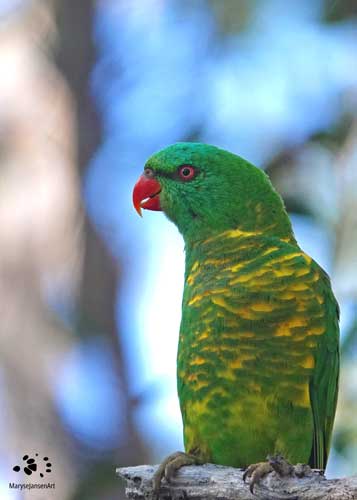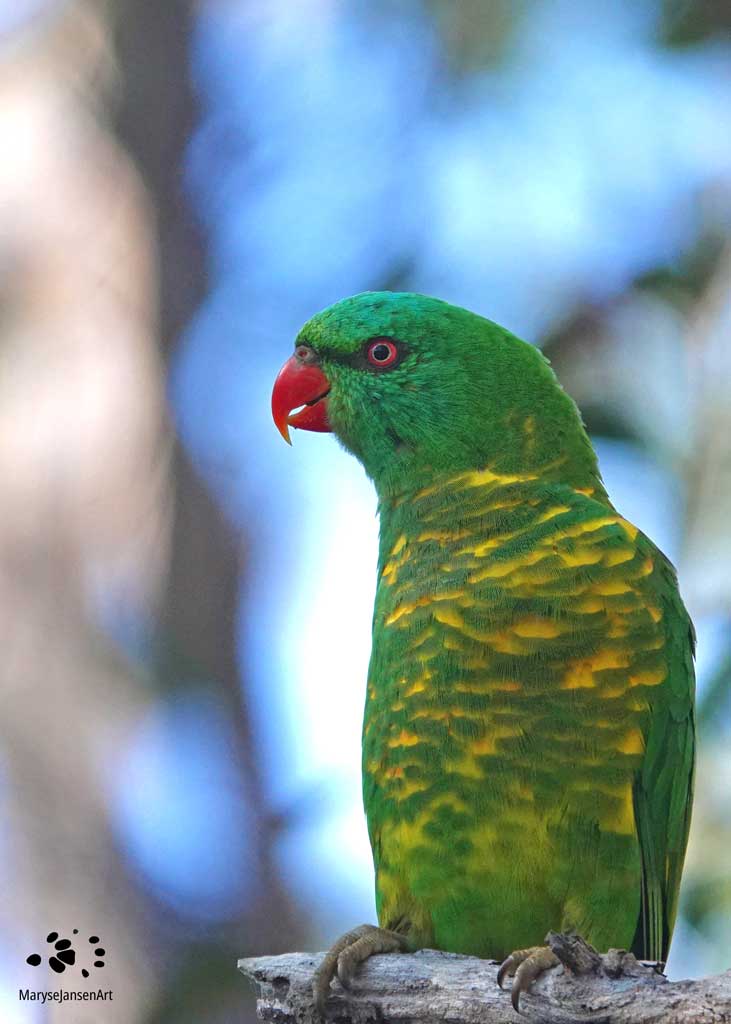Bird Photography with marysejansenart
Scaly-breasted Lorikeet often hangs out with Rainbow Lorikeets

Table of Contents
Scaly-breasted Lorikeet well camouflaged
Soft chatter and a rustling through the leaves above my head attract my attention. A green bird is moving around in the foliage, feeding on the nectar from the flowers. It has a bright red beak and red-orange eyes, but otherwise it is quite well camouflaged amongst its green surroundings. I stand completely still, quietly observing it and slowly more and more of the little parrot comes into view. It is a Scaly-breasted Lorikeet!
When it’s in full view, I can see the head is all green and the upper parts are mostly green as well. A little bit of orange and grey colouring is visible from the underwings and tail feathers. The green breast and neck have yellow markings that look like scales. Actually the feathers on these body parts are yellow with broad green edges, which causes the scaly appearance. The legs are grey-brown.
Hanging out with Rainbow Lorikeets
A loud screech comes from the next branch, announcing the presence of another member of the lorikeet family: the Rainbow Lorikeet! These extravagant birds are much easier to detect as they steal the show with their bright and extremely colourful plumage. The Scaly-breasted Lorikeets can often be seen in flocks with Rainbow Lorikeets as they share similar feeding habits and a large part of their range.
The Scaly-breasted Lorikeet can be found in woodlands along the east coast of Australia, whereas the Rainbow Lorikeet has a larger range, extending to South Australia as well. In more northern areas the Scaly, as it might be referred to colloquially, is much more abundant then in the south.
Here in those more southern regions, the birds only appear when their food trees are flowering so I don’t come across them very often. Today is my lucky day: a Scaly-breasted Lorikeet is foraging in the lower levels of the forest. It is hopping from branch to branch and sits still momentarily as I point my camera on it. I am able to capture this beautiful clean view of the bird, unobscured by foliage! Check it out in the featured image!
Feeding on sweet nectar and pollen
The Scaly-breasted Lorikeets feed on nectar and pollen. Their brush-tipped tongue helps them gather these goodies. They mainly feed on Eucalyptus blossoms, but they also like Melaleucas (Paperbark), Callistemon (Bottle Brush) and Banksia. Furthermore, they will take advantage of many other flowering plants in parks and gardens, such as the flowering Milky Vine here that is attached to the Eucalyptus and Melaleuca trees that line the creek. They may also eat whole flowers, berries, fruit, insects and insect larvae to complement their diet.
These birds can screech and chatter loudly, as many parrots do, but they are a lot more timid then the larger Rainbow Lorikeets. It has been observed that when people put out bird feeders, the Scaly-breasted Lories don’t stand a chance against the Rainbow Lorikeets in getting to this food source.
Breeding Habits
Male and female birds look identical and form strong pair bonds. A pair can be found feeding and preening together. The male will start bopping and hopping to show that he is ready for breeding. Scaly-breasted Lorikeets nest in tree hollows high above the ground. They line the nest with a layer of wood dust and lay two, or sometimes three, eggs. The female incubates the eggs, which takes a period of 25 days. The male does spend some time with her, but he does not take a share in the act of incubating. When the chicks hatch, he does get involved alongside the female in feeding the chicks. After 6-8 weeks, it’s time for the chicks to fledge.
Join me on my walk in the latest episode of ‘Come for a walk in the Australian Bush’ and see how well camouflaged the Scaly-breasted Lorikeet is as it is feeding quietly on the flowers of a vine with large, green leaves. And meet the Rainbow Lorikeet to see the difference in appearance between the two birds.
If you are interested in purchasing a print of the featured image ‘Scaly-breasted Lorikeet’ or would like to see what the it looks like on the various merchandise products, please head to my shop. To see images of the Rainbow Lorikeet and other Australian Parrots, visit my Australian Parrots Collection.


